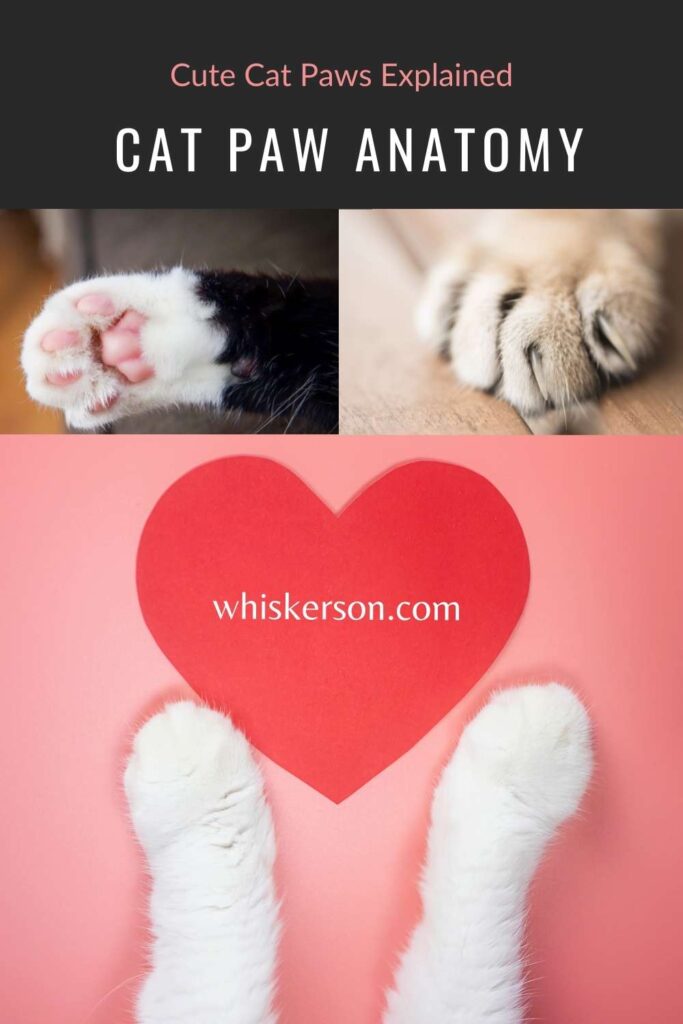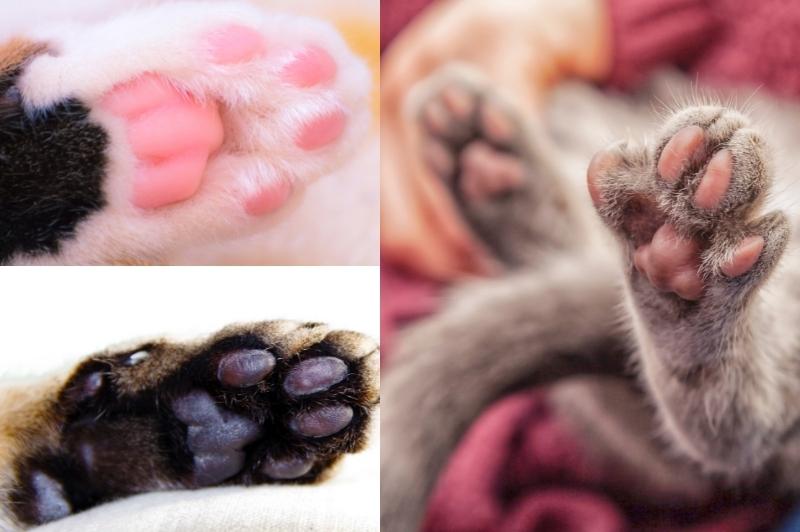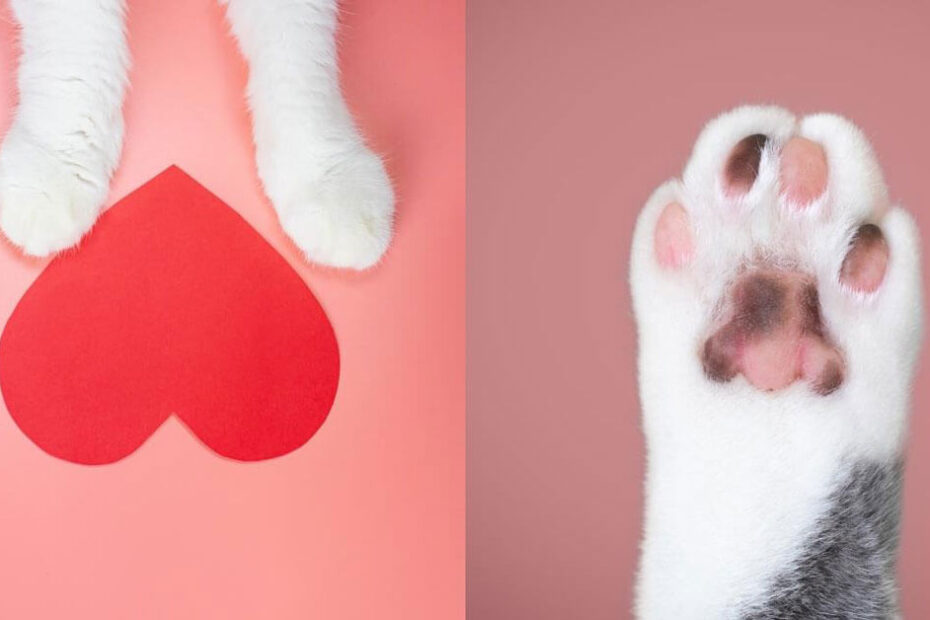Cat paw anatomy is pretty amazing. Cat paws are a vital part of the body that makes your furry companion feel alive and kicking.

Cats use their paws for self-defense, to absorb shocks, to groom themselves, and to climb.
But there is more you need to know about the cute fluffy cat paws.
When you take the time to examine cats’ paws, you will see that they are not only colorful and cute, but they have many surprising features.
In this article, we will discuss all aspects of cat paws, their anatomy, use, care, and kneading.
Cat Paw Anatomy Explained
Cats have beautiful, flexible but also deadly paws. You may be wondering what makes your cat’s paws beautiful and deadly at the same time?
For that, we have to look at the anatomy of the cat paw.
Cats have a total of 18 toes, the front legs have five toes each, and the back legs have four. When we zoom in on the bottom side of a cat’s paw, it consists of fine pigmented pads that appear smooth but tough.
The large pad in the center of all cat fingers provides traction if the cat skids, it also acts as the main cushion, and not to forget it supports the entire leg bone.
Each large pad has four toes attached to them, these are called toe beans because of the way they look, each cat toe also has claws.
The front claws of cats are more lethal than their rear claws because they are used for hunting. When they do not use their claws, they cover them with their fur.
The paws of the front legs are called metacarpals, and the paws of the hind legs are called metatarsals. Cats’ hind legs are stronger than their front legs and can withstand the full impact of running and jumping.
Color of Cat Paws

Why do cats have different color toe pads?
When you look closely at the cat’s paws, you will see that each cat has a different color. The most common colors spotted are pink, black, and lavender.
The color of the cat’s paw mainly depends on the color of its fur.
- Pink bottom paws: light to a medium shade of pink or reddish-brown is found in cats with white or cream coats.
- Black bottom paws: black feet can be seen on any type of coat – although it may not show up as much against darker shades like tabby for example.
- Lavender bottom paws: these are usually only found in breeds such as Siamese and Himalayan which have pale coloring.
There isn’t a set rule about what color your cat’s paws should be, the paw cushions can easily have two colors.
How Does a Cat Use Their Paws?
Cats use their paws in all their activities, and many studies have shown that cats have preferences when using their paws. These fun facts will help you know what your kitty wants to tell you by using her paws.
Grooming: Cats use their paws to groom. You probably have seen cats licking their paws and then using them to wash their ears, head, and face.
Drinking: Some cats like to hold their paw under running water or dip their paw in a bowl of water and then lick it, this is normal cat behavior.
Regulate Body Temperature: Cats use their paws to control their body temperature because they have sweat glands in their paws. With the help of their paws, cats can also withstand lower temperatures and can easily walk on snow.
The reason is that they have more blood circulation in the paws than humans. But they can still get frostbite from prolonged exposure.
Communication: Our cats can use their paws to communicate. Cats have olfactory glands in their paws that release pheromones, and cats use them to transmit chemical messages.
They also use their paws to communicate their feelings. If your cat leaves wet footprints on the surface, and the cat hasn’t been near the water it means your cat is nervous.
Activate Claws: Another important use of cat paws is that of its claws. Cats can extend their claws at will and do this if it’s needed to protect themselves.
Why Do Cats Knead With Their Paws?
Kneading is a common and instinctive trait of cats. It may seem strange to you, but it is a completely normal activity. Most cats enjoy kneading, and they glaze and drool while kneading your lap. Mostly cats knead on soft surfaces.
Here are some popular theories associated with cat kneading.
- Getting ready to sleep
Cats also knead when they get ready to sleep. This kneading is very common in cats, and the root of this process can be traced back to their wild ancestors who kneaded and stroked tall grass to create a soft sleeping space.We know how much cats love to sleep as they spend most of the day sleeping. So whenever you see your feline companion kneading your bed, it means that they are getting ready for sleep. - Marking their territory
Cats also show kneading when marking their territory, as we all know that cats are territorial creatures. Cats have four olfactory glands present in the soft part of their pads.When cats rub their paws on your lap, bed, or furniture, they are actually trying to activate their olfactory glands and mark that area as their own. - Kneading to convey comfort
When cats are happy, they knead to show their pleasure. Cats also knead while snuggling, petting, and in their napping spot.When cats settle on your lap, they knead to show their joy and love. Similarly, if your cat is stressed, they will knead to calm down.
How To Take Care of Cat Paws?
If you inspect your cat’s paws regularly, it will be good for their health, and if something is wrong, the cat paws can inform you about it. If your cat is limping, it could mean that a nail or thorn has been stuck in its paw or has been injured in some way.
Cats are masters at hiding their pain, but you need to pay close attention to keep them in good condition. Here are some tips that will help you take care of your cat’s paws.
Clean Their Paws
Inspect your cat’s paws regularly and if the paws are dirty you can use a moist cloth to clean the paw pad and also clean between the toes. This will clean your cat’s toes for debris, dust, and any foreign or chemical objects.
If your cat is healthy and is not a kitten or old, they will clean their paws themselves because they lick their paws on a daily basis, multiple times a day.
As a cat owner make sure that no chemicals are used in your household or the floor.
Trim Their Nails
Trim their claws with the help of clippers specially designed for cat nails. While trimming their claws, cut only the nail’s tip and leave the sensitive part that contains nerves and veins. Never clip the nail near the pink part of the cat nail, this is the sensitive part!
Dry Cat Paws
A common problem most cat owners face is that the pads on their cat paws often crack, become irritated and dry. Veterinarians generally recommend moisturizers that contain coconut oil, olive oil, or any other food-grade oil.
You can hydrate their paws, confine them for a few hours to absorb the oil to prevent this. If the problem is severe, see your vet. Never use human lotion and petroleum jelly on their paws, because your cat will lick it off.
It’s best to use natural-based moisturizers like the mentioned oils.
Final Thoughts
We spend a lot of time snuggling with our cats, but knowing your cat’s paws’ anatomy is important because they play an important role in their daily activities.
Make sure you check the cat soles for dryness and make sure that their cat nails are trimmed. If your cat baby has a wound or is limping in any sort of way, we would like to advise you to see the vet right away.
